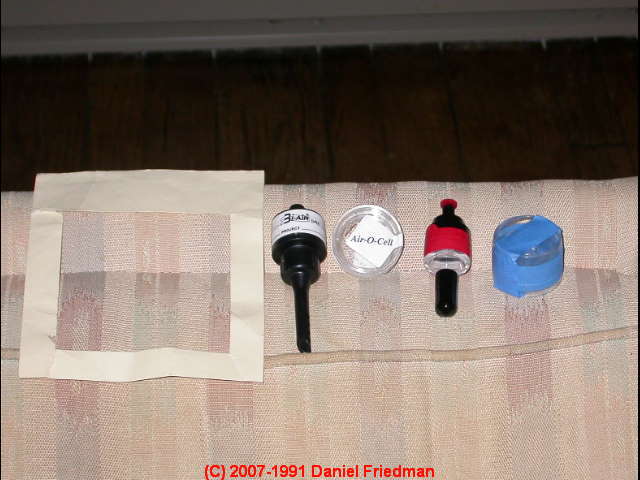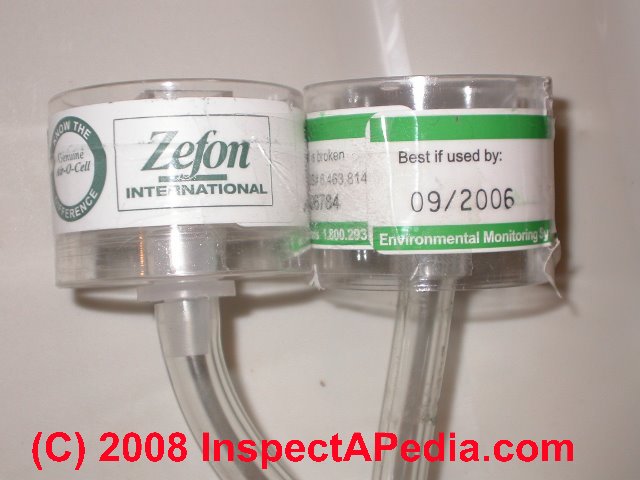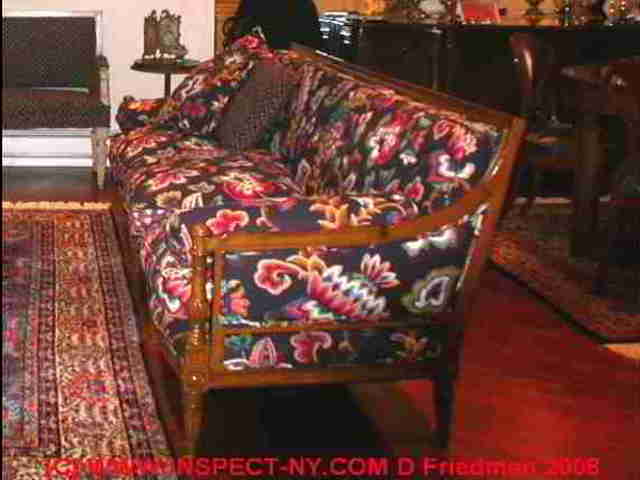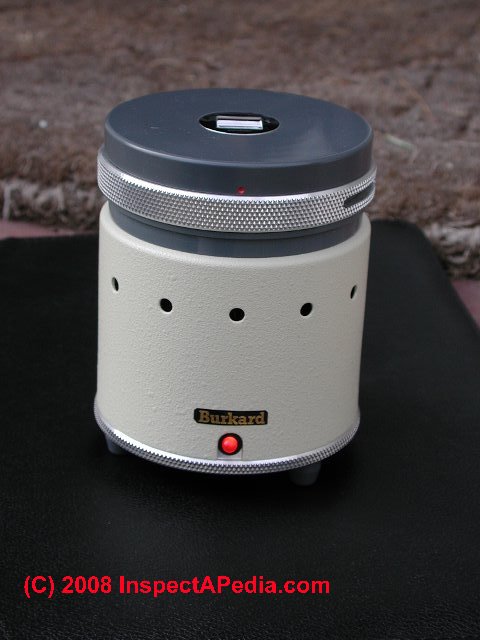 Vacuum Cassettes / Spore Traps for Mold, Particles, Dust
Vacuum Cassettes / Spore Traps for Mold, Particles, Dust
How to use vacuum cassettes to collect environmental samples
- POST a QUESTION or COMMENT about using vacuum sampling methods to test for building dust or mold contamination
Vacuum cassette test methods for building dust or mold.
This article explains the advantages and shortcomings of using vacuum cassettes or spore traps to collect mold test samples (or other dust or particle samples) from indoor surfaces such as carpets, couches, or multiple hard surface dust samples:
How to do it & Guide to Good Dust Sampling Practices.
In this article series we discuss the validity of nearly all of the popular mold testing methods currently in use, pointing out the strengths and weakness of each approach to mold sampling in the indoor environment, beginning with air sampling for airborne mold levels indoors.
InspectAPedia tolerates no conflicts of interest. We have no relationship with advertisers, products, or services discussed at this website.
- Daniel Friedman, Publisher/Editor/Author - See WHO ARE WE?
A Guide to Using Vacuum Samples for Screen Buildings for Toxic Mold
[Click to enlarge any image]
15th Annual North Carolina/South Carolina
Environmental Information Association Technical Conference
Myrtle Beach, SC
Daniel Friedman 23 September 2005, Updated 4/14/2009 & 10/5/2012
A collection canister is connected to an air or vacuum pump which is used to draw particles onto a filter-surface or into a special collection container.
A collection device, slide, cassette, or tape are used with a calibrated air pump to collect surface particles.
The lab prepares a slide from the cassette (of the types below) or if an MCE filter cassette was used to collect particles, the lab clears the filter onto a microscope slide, washes the filter onto a microscope slide, or uses another method to transfer particles for examination by microscope for preparation by culture.
Our MOLD INFORMATION CENTER includes more broad discussions of the overall approach to building investigation, as do many expert references cited at that web.
For a more comprehensive collection information about mold test methods
see INDOOR AIR QUALITY METHODS COMPARED. For more on "mold classes" (Cosmetic mold vs. allergenic mold vs. toxic or pathogenic mold)
see MOLD CLASSES, HAZARD LEVELS and more references such as a Mold Action Guide are at the end of this document.

Using a simple portable pump calibrated to a known flow rate allows rough estimation of particle density per square inch of surface tested if that analysis is needed.
People using this approach may make use of a disposable paper square template that defines a precise surface area to be vacuumed (photo above left). In our opinion a precise quantitative approach to surface vacuuming is silly because there is normally large particle variation over building surfaces for many reasons. But the approach is useful to screen for high levels of particular particles (such as mold spores, animal dander, insect allergens).
Our photo (left) shows five vacuum test areas on a hallway carpet during a study conducted by the author to examine the variation in particle deposition by foot traffic in a residential hallway.
Our hypothesis was that more outside dirt and debris could always be found in the center of the main path of foot traffic even though that area also received more aggressive vacuum cleaning than the hallway sides. We have tested carpeting before and after various types of cleaning and after suffering various types of contamination.
Surface vacuuming for mold
We emphasize that in this article we are discussing surface vacuuming to collect particles from an exposed surface onto which the vacuum device and collector can be placed directly.
This is an effective and useful particle or mold sampling method.
We are not referring building wall or ceiling cavity vacuuming methods that attempt to draw air and particles from the building cavity through a punctured opening and tube into a collecting device - an approach that our test found was ineffective.
We discuss building cavity vacuuming below
at VACCUMING BUILDING CAVITIES
Vacuum samples can be useful for testing soft goods (clothing, bedding, curtains, carpets) for high levels of contaminated spores in a qualitative approach.
We particularly like vacuuming a number of surfaces in an area using a single collection device as a less-costly way to make a more confident inspection of the level of contamination by moldy dust in buildings with a known problem.
We also use this method as part of a mold clearance inspection to evaluate the thoroughness of both the containment system and the general cleaning effort.
For example we may collect a sample of vacuumed surface dust from 10 different surfaces in 5 rooms on a floor of a home, forming a more broad screen for moldy dust than single tape lifts of surface dust.
We've found wide variety in levels of mold found growing in or on carpets, depending on a number of variables including even the level of other dirt present in the carpeting.
Some experts question this measure.
Carpet vacuuming for mold is interesting as a pre and post remediation baseline data source for areas out of the remediation/containment area, but for any carpet this method quickly overloads a particle sampler.
The Burkard personal air sampler (photo above) can also be used to vacuum particles from surfaces provided that a strong air flow is not required to lift the particles from the surface (this device pumps at 10 lpm).
Shortcomings of surface and carpet vacuuming for mold
- Vacuuming will not collect
identifying structural components
of mold as well as tape and will almost certainly damage or destroy the structures which it collects, imposing some limits on identification - Vacuuming will not collect
all of the material on a hard surface
(which tape handles well). Particles which are easily lifted by the airflow into the canister will be over-represented compared with sticky particles which are adhered to the test surface.
This problem is particularly sensitive to the flow rate (LPM) used. A low-flow rate (1LPM) avoids a sample overload problem (too many particles, can't read the sample) but may fail to collect or under-collect certain particles.
A high flow rate improves particle pick-up but then limits the number of sample sites (increasing test cost) in order to avoid sample overload. We suspect that no vacuum method we have tested could reliably pull mold or debris reliably from deep inside a heavy upholstered couch. - Carpet vacuums and some
furniture or drapery vacuums will either be overloaded
or restricted to culture (to which we have already objected).
...
Reader Comments, Questions & Answers About The Article Above
Below you will find questions and answers previously posted on this page at its page bottom reader comment box.
Reader Q&A - also see RECOMMENDED ARTICLES & FAQs
Need guidance on dust sampling or testing methods
I have looked at several articles, but the answer for me is not that easy.
We live in a 1528 Sqft home. And the dust that gets in our home is just unbelievable. With the new A/C unit we recently put in, the dust has gotten worse, but I kin of expected that as a new unit is probably pulling more air in and out.
I can put a 20" box fan in the middle of a room with a merv 11 filter on the back and within 3 weeks the filter will be dirty.
The 2 rooms left with carpet are the worse and i know the carpet does not help, especially since is really old. The original duct work ( 30 years old ) cannot be accessed in the attic.
My question is where do I start? We have had an environmental company test and seal and the reduction got down to about 28% from 45% loss. I feel from reading a good place to start may be placing the dust capture squares to actually identify what kind of dust is present. Hopefully dust on a piece of furniture will work also, as that is not hard to get.
Thanks so much for any direction you can offer.
Jim 2014-08-01
by Jim B.
Reply by (mod) -
Jim
Your question about house dust in our article on dust sampling methods may be confusing to some readers.
Basically to control a dust problem I'd look first for
1. the principal source of the dust - if it's not obvious then collect a couple of settled dust samples for lab analysis to determine the dominant particles.
With the source identified we may understand that source removal or amendment are in order.
I like to clean a horizontal surface, then let dust accumulate for a week or two for sampling. That way I know we're looking at current conditions.
2. Improved air filtration and fan use to reduce indoor dust levels. SeeAIR FILTER OPTIMUM INDOOR about cascaded air filters
and see
BLOWER FAN CONTINUOUS OPERATION about continuous blower fan operation.
As you say the dust is worse since installing [central?] air conditioning, I'd look close to the return register to see if there is a particular dust source nearby.
...
Continue reading at VACUUMING BUILDING CAVITIES or select a topic from the closely-related articles below, or see the complete ARTICLE INDEX.
Or see these
Recommended Articles
- DUST SAMPLING PROCEDURE
- INDOOR AIR QUALITY METHODS COMPARED
- MOLD TEST PROCEDURES
- TECHNICAL & LAB PROCEDURES
- MOLD / ENVIRONMENTAL EXPERT, HIRE ?
- VACUUMING BUILDING CAVITIES
- VACUUM CASSETTE FILTER SAMPLE TESTS for DUST / MOLD
- VACUUM SAMPLING EQUIPMENT, DIY
- VACUUM TEST INSULATION CONTAMINANTS
Suggested citation for this web page
VACUUM CASSETTE FILTER SAMPLE TESTS for DUST / MOLD at InspectApedia.com - online encyclopedia of building & environmental inspection, testing, diagnosis, repair, & problem prevention advice.
Or see this
INDEX to RELATED ARTICLES: ARTICLE INDEX to BUILDING ENVIRONMENT
Or use the SEARCH BOX found below to Ask a Question or Search InspectApedia
Or see
INDEX to RELATED ARTICLES: ARTICLE INDEX to MOLD CONTAMINATION & REMEDIATION
Or use the SEARCH BOX found below to Ask a Question or Search InspectApedia
Ask a Question or Search InspectApedia
Try the search box just below, or if you prefer, post a question or comment in the Comments box below and we will respond promptly.
Search the InspectApedia website
Note: appearance of your Comment below may be delayed: if your comment contains an image, photograph, web link, or text that looks to the software as if it might be a web link, your posting will appear after it has been approved by a moderator. Apologies for the delay.
Only one image can be added per comment but you can post as many comments, and therefore images, as you like.
You will not receive a notification when a response to your question has been posted.
Please bookmark this page to make it easy for you to check back for our response.
IF above you see "Comment Form is loading comments..." then COMMENT BOX - countable.ca / bawkbox.com IS NOT WORKING.
In any case you are welcome to send an email directly to us at InspectApedia.com at editor@inspectApedia.com
We'll reply to you directly. Please help us help you by noting, in your email, the URL of the InspectApedia page where you wanted to comment.
Citations & References
In addition to any citations in the article above, a full list is available on request.
- In addition to citations & references found in this article, see the research citations given at the end of the related articles found at our suggested
CONTINUE READING or RECOMMENDED ARTICLES.
- Carson, Dunlop & Associates Ltd., 120 Carlton Street Suite 407, Toronto ON M5A 4K2. Tel: (416) 964-9415 1-800-268-7070 Email: info@carsondunlop.com. Alan Carson is a past president of ASHI, the American Society of Home Inspectors.
Thanks to Alan Carson and Bob Dunlop, for permission for InspectAPedia to use text excerpts from The HOME REFERENCE BOOK - the Encyclopedia of Homes and to use illustrations from The ILLUSTRATED HOME .
Carson Dunlop Associates provides extensive home inspection education and report writing material. In gratitude we provide links to tsome Carson Dunlop Associates products and services.





